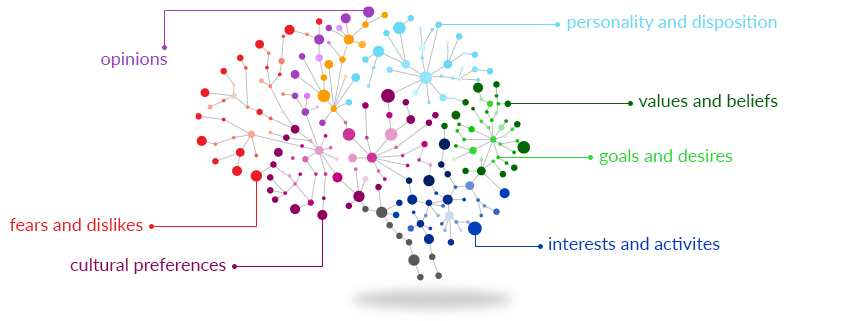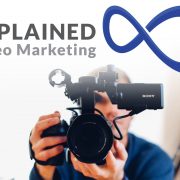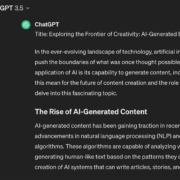What Is Psychographic Segmentation And How Can It Help Your Business?
Here at iSynergy, we’re a full-service digital marketing agency. We do SEO, creative design, ad placements, website design and hosting, among other things. In this blog, we’ll discuss a variety of industry essentials related to formulating an effective message to serve to your target audience.
Creating a message that resonates with your potential customer base–and ultimately results in revenue–can be a complex process. Before you can fine-tune that message and implement an effective marketing strategy, you need to perform the right market research. That will include delving into various forms of market segmentation, which is the practice of taking a broad audience and breaking it down into smaller groups, based on some shared trait(s).
Most people are familiar with demographic segmentation, which is based on characteristics such as age, gender, income, race, education level, location, employment and relationship status. Psychographic segmentation goes a step further and provides insightful information on aspects such as personality traits and social class.
There are some exercises and tactics here you can do in a couple of hours, while some others can take a couple of weeks (or even a couple of months). Some you’ll need to audit quarterly or yearly. The ROI on the time invested in uncovering psychographics is going to be higher than any other strategy. You’re going to have more insight than ever before into your consumer, your audience, and your buyer.
-
- Customer Persona
- Understanding Psychographic Data
- Activities, Interests & Opinions
- Personality and Disposition
- Values and Beliefs
- Goals and Desires
- Fears and Dislikes
- Cultural Preferences
- Personalization
- Profiling Tactics / A Day in the Life
- Observe & Document
- Consumer Lifecycle
- Monitoring and Tracking
- Media Consumption
- Content Format
- Trigger Topics & Contextual Retargeting
- Interviews & Surveys For Data Integrity
- A/B Testing for Optimization
- Digital Marketing Platform (DMP)
- Conclusion
Customer Persona
We always make a point to ask our clients to clearly identify who their target audience is. And they often say, “well I want to be able to sell something to everyone”.
That’s an admirable goal, but in reality, it’s critical to understand where the majority of your transactions come from. Where is the highest ROI on your marketing efforts and advertising budget?
Constructing a mental image of your [semi-fictitious] ideal customer is an incredibly valuable exercise in the process of outlining an effective marketing strategy. Some businesses might have a single customer persona, though it’s not recommended. Some are going to have three to five, and some more than that. At iSynergy, we prefer to live in that three to five range because it allows for a priority list: your good, better and best buyers.
Build your customer persona from the ground up. Where do they live? What’s their education level, marital status and household income? How many children do they have? Be as specific as possible (many marketing experts even recommend giving them a name). Once your customer begins to take shape with this basic demographic data, you can start to envision them as a real person, which assists in understanding their needs.
There are pros and cons to the customer persona and demographic segmentation. While the defined characteristics are tangible and quantifiable, they can likewise be somewhat restrictive to your creative approach for specific marketing communications. Being overly reliant on demographic data can lead to a generic message that casts a pretty wide net. Do you want to use a sniper rifle or a water balloon to hit the target? You want the sniper rifle so you can pinpoint and target with a great amount of accuracy! Psychographic data can help.
Understanding Psychographic Data
Demographic data tells you who the buyer is. Psychographic data tells you why they buy.
Have you ever wondered why a consumer did or didn’t purchase from you? Psychographic segmentation helps to answer that question. It’s not tangible or quantifiable, but it IS qualitative.
Integrating a psychographic profile in your customer persona can add depth and help paint a more complete picture. If you thoroughly understand why people bought from you (on top of defining who the person is), you can take your marketing strategy to the next level.
From a creative standpoint (or a sales copy standpoint), you can be ultra-targeted with every written word, whether it be your website copy, your email marketing, the call-to-action on your ads, or your social media copy.
This data can be taken further by incorporating it with media like pre-roll, post-mid-roll, OTT or even traditional outlets. If you understand the “why” behind a purchase, then you can utilize that data for any form of creative (even outdoor media), and get more bang for your buck.
By using psychographics, your messaging will be better-received by an audience that is more likely to buy.
Activities, Interests & Opinions
Psychographic information encompasses AIOs (Activities Interest and Opinions), which help to define your target audience; their lifestyle choices, hobbies, interests outside of work, etc.
Characteristics like employment and income are flushed out in the demographic data, but if you want to know what they do after work, where they go, their hobbies and interests, opinions and attitudes… that’s where AIOs come in to play.
If you’re familiar with Simon Sinek, he has a great TED Talk out there and a few good books for resources. He explains AIOs like this; “people don’t buy what you make, they buy why you make it.”
If you can find the consumers who relate to your brand, and then explain how you are properly aligned with them, the sky’s the limit! You can tell them why you do something and whether they support that or understand it basically comes down to culture.
It’s “I don’t have just have a widget to sell, but I have this widget to sell and this is why I sell it…This is why it’s so important to me…This is the story on why we developed it, how we came up with it, and here’s our process for fine-tuning it.”
A great example of this (whether you like them or not) is Apple. Their products have a cult following. You can’t deny the fact that their audience blindly follows. This is less a function of what Apple makes and more about why and how they make it.
Personality and Disposition
You must know the personality type and disposition of the typical customer in your target market(s). If you’re a cutting edge brand, such as a tech company trying to break into the market, your primary audience won’t be the baby boomer generation. This may be painting a group of people with a broad brush, but historical data shows that baby boomers generally aren’t early adopters of technology. Yes, there will be outliers, but we don’t market to the exceptions, we market to the rule!
Keep your messaging in line with the personality and disposition of the primary (and secondary) audiences who are more likely to purchase.
Values and Beliefs
Strong ideologies in today’s climate include things like religious and political views. Marketing around these topics can be tricky, but if you’re willing to associate your brand with a particular stance, it can pay off with a passionate and loyal customer base. On the flip-side, there is the risk of alienating a segment of consumers that may be critical to your success. It’s always best to assess these scenarios on an individual basis.
On any given issue, you may be firmly on one side of the fence or the other, so it’s really a matter of navigating opposing beliefs. If you can define and evaluate your highest priority customer persona (and determine which side of that fence they’re on), it’ll give you valuable insight on how and where to target them with the most effective ad placement and messaging.
Goals and Desires
What motivates your buyers? What do they want to achieve? What do they aspire to be?
This approach is especially strong with modern health trends, such as exercise/nutrition programs and supplements. But it’s also relevant to various other aspects of business and home life.
What struggles and challenges do your consumers have and what do they do on a day-to-day basis? Does it relate to their age, appearance, or even social status?
For example, the struggles of a mother with a toddler and a newborn are probably related to child care, providing for her family, maintaining a balance and creating a safe environment where her family can flourish. This analysis provides guidance in predicting their struggles in that day-to-day persona.
Fears and Dislikes
What are your buyers afraid of? What don’t they like? Understanding fears and dislikes is equally as important as knowing their goals and desires. Fear is one of the strongest human emotions and can be a compelling force when used properly in advertising.
Cultural Preferences
Messaging needs to be tailored to specific cultures and regions. For example, when you’re doing a national campaign, you may have to adjust your design or copy for a specific area–terms used in Texas may be completely unknown in northeast Ohio. DIfferences can be even more stark when considering multinational marketing. You’ve got to have a firm understanding of how certain messaging will be received among different populations.
Personalization
You can use all of the above to integrate personalization and increase the quality and effectiveness of your messaging. When practical, you should strive to make your content as personal as possible. If you don’t have access to market research on AIOs, psychographic data, etc. (for instance, consumers in older generations tend to be highly protective of their information, resulting in less available data), use what you have to make your message stand out as much as possible.
Profiling Tactics / A Day in the Life
Sit down with your team (most of these tactics are group-based because multiple brains are better than one). That’s why we have regular internal brainstorming sessions. Whether it’s an upcoming social media campaign, marketing strategy for a new product, or a general client discussion, we do frequent roundtables because it fosters a creative atmosphere where everyone has input. You never know when one unique perspective could trigger a cascade of new ideas and feedback. There’s a good reason focus groups have long been a staple of market research.
We have these sessions to allow ideas to flow freely, especially when it comes to “a day in the life” of our clients’ customer personas. Document the visualization of those personas, whether its on paper, digitally, or on a whiteboard.
When you establish threads of activity relating to what that persona experiences (from the moment they wake up until bedtime), you can easily come up with countless informative observations. When you put pen to paper and see that timeline in front of you, you’re able to glean actionable insights from that data, based on that persona’s typical day.
This is especially valuable for dayparting strategy–if you identify who your buyer is and when they’re consuming media, you can bid appropriately and schedule ad placement at optimal times.
Let’s assume the customer consumes 90% of their data and media from 1 p.m. to 3 p.m. If you’re dayparting your advertising strategy (search, display, video, OTT or even traditional TV), you’re going to focus on that timeframe because that’s when they’re consuming everything. If 90% of their consumption happens in that period and you’re not targeting them at that time, you essentially have less than a 10% chance to reach them during the rest of the day.
Observe & Document
This tactic is old-school market research, and a very basic form of behavioral segmentation.
Traditionally, you can hire a firm that physically goes out to where consumers are and documents their findings (what consumers were doing, when and where they are consuming, etc).
The downside? This grassroots approach of curating information is not always practical or scalable. For example, if you’re running a national campaign as a local B2C brand, you might not have the resources to employ this strategy. However, you CAN document and record your incoming sales calls (a lot can be gleaned from your inbound phone calls).
This applies to service calls, also. Listening to existing customers and their pain points (as well as what they’re happy about) is critically important. This information will eventually help you close that loop with your service department (or even fulfillment, if you’re an ecommerce store).
Consumer Lifecycle
Analyzing the consumer lifecycle as it relates to interaction with your brand is one of the tactics many marketers execute first. It typically consists of creating a diagram or workflow and documenting the consumer’s journey.
Just make sure that your information isn’t biased (i.e. your assumptions about your brand). Base your lifecycle on supportive data from your website analytics and conversion information. What triggered a particular conversion? How many times were they exposed to your message or brand, and what is the view through rate? Where did your conversions come from?
Google Analytics provides high-quality insight. Pixel tracking can be utilized to document how visitors found you (where they saw your ad), what their subsequent stops were, and if they ever came back. This insight can show you how many times they were exposed to your ad before actually converting. Did they see it five times? If so, what did their journey entail between those five impressions? All of these data points will help you more accurately document the consumer lifecycle.
Monitoring and Tracking
You can pull data from Google Analytics or tracking pixels about where, when, how and why your audience engaged online. With social listening, you can get insight into your buyers and their personalities, giving you a clearer picture of the consumer’s life outside of your brand. What are they talking about (not just about our brand or about your product)? How did they get on the topic of our brand in the first place?
You’ll learn a lot more by listening than you will by talking. Major brands review forums and threads on Reddit to observe how their product is being discussed and how they can improve. So how would one monetize this group of 5,000 people that they belong to? Figure out what they’re talking about and the other areas of interest that those group members share (outside of that group) and use that information to target similar consumers. They’re in that group to be with people that have a similar mindset and interests. That’s how you use community engagement online (with circles like Reddit, forums and Facebook groups).
Another great tool that is often overlooked is the product review. If you have your own reviews–or those from a competitor–capitalize on that insight. Reviewers have the distinct perspective of having experienced your brand (or your competitor’s), and provide firsthand critiques of the product.
If they gave a five-star review, why? Was it the exceptional nature of the product itself, the sales process, or was it the fulfillment experience they enjoyed? Perhaps after filing a complaint and/or dealing with customer service, the issue was rectified in short order and you earned a five-star review for that?
There are valuable nuggets of information you can absorb from your product or company reviews, as well as those of your competitors. Many business owners don’t consider.
Media Consumption
Media consumption habits correspond to both demographics and psychographics. Where are your personas and how are they getting their media? What device do they use to consume that media: mobile, laptop, tablet, a television? Is traffic being directed from referral sites, are they getting their content from search engines, where are they consuming that media?
The typical consumer spends 1 to 1.5 hours daily on social media, but there are wide variations across segments. Adults average under an hour, but the 16-24 age range averages 3 hours. If you’re really advanced, you can then go on to define which social channels they were on, for what length of time (i.e. Facebook for an hour and then Pinterest for a half an hour), and the type of device they used. That information can come from Google Analytics, tracking pixels and third-party tracking software..
Content Format
What type of format is your consumer using to obtain information and how are they getting it? Are they getting it by the way of videos, blogs, social, OTT, network TV, connected radio?
For example, if it’s network TV or OTT, does most of their content from Fox, CNN, or ESPN? Is content delivered or referred from influencers? Do they subscribe to blogs like RSS feeds or email subscriptions? There are some intense ways to target customers.
If you want to target someone that receives regular emails from Kohl’s department store, there are ways to know if your top priority customer persona subscribes to Kohl’s emails. Knowing the type of content that they consume–and where–can give you a big advantage
Trigger Topics & Contextual Retargeting
This is an easy one. Let’s assume you have a soft spot in your heart for dogs. If my health food brand is beginning a campaign for a new protein supplement, and I know that my typical consumer loves pets (dogs, in particular), maybe I run ads showing them jogging with their dog, then enjoying my supplement. It’s just better messaging – advertising 101. Environmental pleas, food and travel are all topics that can trigger audience emotion.
Contextual retargeting is when you’re aware of your consumer’s interests outside of your brand, and you use those interests as an avenue to deliver your message. So, if your consumer loves dogs and you’re executing paid digital advertising, use contextual targeting to reach users that go to animal shelter sites, pet care websites, etc.
Every website on the Internet is tracked and categorized by the Interactive Advertising Board so you can contextually retarget people that show a tendency or recency to visit that category of website.
That’s contextual retargeting and trigger topics – things that evoke a positive, emotional response from your consumers. With historical search, you can even construct data based upon somebody’s search history eight months ago (or even years ago).
Interviews & Surveys For Data Integrity
Where does the most reliable information come from? Well, if you want to know more about who your customer is, go straight to the source. Ask them why they bought from you! Most buyers are pretty happy to answer that.
Many times, brands are just afraid to do this because they got the sale and now they’re afraid to engage the consumer further. But this is the ideal time to talk to them – they already said yes to you by making a purchase! Not doing this is like asking someone out on a date, they say yes and then you never show up.
Go through with it. Ask the consumer why they purchased from you. More often than not, they’re going to give you some worthwhile insight.
If you have a large audience, conduct a survey. You can automate it, and even if you get a 1% response rate, it’s going to provide insight. If you’re B2B and you failed to close a lead, ask why! Does another company do something more efficiently? You can learn just as much from the losses as the wins.
A/B Testing for Optimization
Test, optimize and fine-tune everything to shine a light on the audience’s tendencies. All your digital ads should be A/B tested by running multiple versions. But, remember, only test one component at a time. If you revise the copy, leave the image unchanged. If you adjust the image, don’t alter the copy. This will allow you to determine how the variables influence the effectiveness of the ad.
Digital Marketing Platform (DMP)
Finally, use a DMP, or digital marketing platform, that utilizes business intelligence to define who it thinks your customer persona is. DMP’s have consumer profiles built out that are better than you’ll probably ever be able to do yourself. Obviously there’s a fee involved, so it’s important to evaluate what your time is worth compared to outsourcing.
Conclusion
The above are all tactics we use at iSynergy to gather information and help us execute as well as possible. Some are in line with traditional thinking and some are outside the box. Some we like better than others, and over time we’ve found some to have a higher success rate. It all depends on your specific circumstances, such as customer persona, target audience, vertical, etc.
If you’re interested in learning more about how to make psychographic segmentation work for you, or talking in-depth about your situation, feel free to reach out!
















